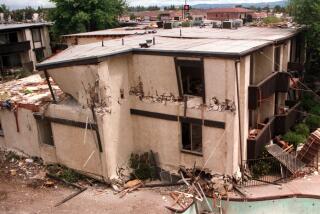Down Around Midnight: A Memoir of Crash and Survival by Robert Sabbag, I’m Off Then by Hape Kerkeling, Vanessa and Virginia by Susan Sellers
Down Around Midnight
A Memoir of Crash and Survival
Robert Sabbag
Viking: 216 pp., $25.95
“The things I remember,” writes Robert Sabbag of the night 28 years earlier when the plane he took to Cape Cod crashed in a forest outside Hyannis, “are among those things I continually have to remind myself to forget.” Sabbag was 32. He had a bestselling book, “Snowblind,” about the cocaine culture. An hour and a half from LaGuardia, Air New England Flight 248 was just 2 1/2 miles from landing in Hyannis when it crashed into some trees at 123 knots. The wings were sheared off, the pilot was killed. Sabbag, whose back and pelvis were broken, and the co-pilot and eight other passengers survived.
It took an hour and a half for rescuers to find them, and it is this period that Sabbag tries, through the haze of traumatic stress, to remember. He visits and talks with other survivors of the crash. “Memory,” he writes, “in the inconstancy of its affiliations, is more than simply capricious, it’s downright irresponsible.” Sabbag recognizes the sadness he feels whenever he boards a plane, a heaviness and sometimes even back pain. The probability of being in a plane crash is 1 in 11 million. Nearly 96% of passengers in U.S. plane crashes survive. “In even the most severe crashes, one’s chances of walking (or maybe crawling) away are slightly better than fifty-fifty.” But the most fascinating part of this book is the effort it takes Sabbag to fit his memory to reality; to create a collage of his and his fellow survivors’ experiences. It is an act of clearing; brush, memory.
I’m Off Then
Losing and Finding Myself
on the Camino de Santiago
Hape Kerkeling, translated
from the German by Shelley Frisch
Free Press: 334 pp., $15 paper
One of the best things about reading accounts of other people’s pilgrimages is you don’t have to do them yourself. You get much of the reward and none of the pain. Virtuously, you identify with the author’s need for a spiritual quest without admitting, yourself, to any such need. Scenery without rain, effort without hunger -- need I go on? The 500-plus mile Camino de Santiago, walked by more than 100,000 people each year for the last 1,200 years, crosses some of the most beautiful scenery in the world -- the Pyrenees, the Basque country, through the Rioja region in Spain. Hape Kerkeling, a comedian from Berlin, undertook the trek after sudden hearing loss and gallbladder surgery forced him to take a vacation from work. He keeps a journal, reporting on his daily revelations in a voice that reminds this reader of Bill Bryson. Kerkeling’s expectations are modest; he struggles to quiet his overly critical mind. It’s a six-week dialogue between heart and mind and feet, with refreshingly little talk about God.
Vanessa and Virginia
A Novel
Susan Sellers
Houghton Mifflin Harcourt: 216 pp., $23
Vanessa Bell was the earth mother, the painter, the older sister. Virginia Woolf was the nervous, brilliant writer, the younger sister. Both were thrown into adulthood prematurely when their beloved mother died; neither really knew how to manage a household, much less a bohemian household, replete with creative guests, frightened children and irritable servants. Written in Vanessa’s voice, this novel accentuates the competitive nature of their relationship. Vanessa, the worrier, bears the burden of family pain. She is worn to a nub, a survivor. “I work on a cover for your final novel. I draw curtains pulled across a stage, showing the fall of the fabric with quick marks of my pen. The sides dissolve into an abundance of flowers. I want to suggest that the play will be engrossing and rich. I put the title of your book at the top, making the words part of the design. I write our names, distinctly, proudly. I wonder if I should put a gap into the curtains so that we glimpse something of the drama. What was it you said? It is not what we put in the frame that endures.” Sellers weaves an enormous number of visual details into her story, as well as bits of dialogue and references from the many writings that survive the sisters. We see again the strength of their bond, their fragility and the endurance of the books and paintings they created.
More to Read
The biggest entertainment stories
Get our big stories about Hollywood, film, television, music, arts, culture and more right in your inbox as soon as they publish.
You may occasionally receive promotional content from the Los Angeles Times.






